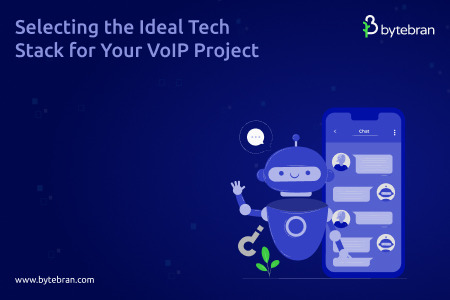Don't wanna be here? Send us removal request.
Text
Selecting the Ideal Tech Stack for Your VoIP Project

Software development involves various technologies and processes that are constantly evolving with new tools and frameworks. While these advancements simplify development, they also add complexity when selecting the right technologies for a project. Beyond the technical aspects, successful software development requires strong teamwork, project management and communication among diverse teams. These skills are crucial for keeping projects on track and within budget. Our blog article aims to give you a clear understanding of the crucial factors to consider when choosing the right technology stack for your software development project.
Understanding the tech stack
A tech stack is a set of tools and technologies used to build and run an application to cover everything from servers and databases to frontend and backend frameworks. Here’s a quick look at its main components:
Frontend: Handles the user interface and experience with technologies like HTML, CSS, JavaScript, and frameworks like React, Angular and Vue.js.
Backend: Manages business logic, database interactions, and server setup using languages like Python or Ruby and backend frameworks.
Databases: Store and manage application data, including relational databases like MySQL and NoSQL databases like MongoDB.
DevOps and Cloud Services: Ensure your application is integrated, scalable, and well-maintained.
VoIP Platforms
FreeSWITCH, Kamailio, OpenSIPS, and Asterisk are top platforms for creating VoIP services.
FreeSWITCH is an open-source platform that connects and routes communication protocols.
Kamailio and OpenSIPS are high-performance SIP servers for managing voice, video, and real-time communication.
Asterisk is a free framework that turns a standard computer into a powerful communication server.
Tech Stacks in Practice
Have you ever wondered what technology stacks power your favorite brands? Let's explore the tech stacks some industry leaders use and see what they rely on to deliver their services.
Uber Tech Stack:
Web Servers: NGINX, Apache
Databases: MySQL, PostgreSQL, MongoDB
Server-side Framework: Node.js
Programming Languages: Python, Java, JavaScript, Objective-C
Uber's tech stack combines robust web servers with versatile programming languages and frameworks, enabling smooth communication and data management across its platform.
Instacart Tech Stack:
Server: NGINX
Databases: PostgreSQL, Redis
Server-side Framework: Rails
Programming Languages: Ruby, Python, Objective-C
Instacart uses a streamlined stack focused on efficiency and reliability. It strongly emphasizes fast database operations and a robust server-side framework.
Reddit Tech Stack:
Server: NGINX
Databases: PostgreSQL, Redis
Server-side Framework: Node.js
Programming Languages: JavaScript, Python
Reddit's stack is optimized for handling large amounts of user-generated content. It uses powerful databases and a modern server-side framework to maintain its performance and scalability.
These examples highlight brands' different choices in building their tech stacks tailored to their specific needs and operational demands.
Choosing the Right Tech Stack for VOIP App Development
Selecting the right tech stack for app development can be overwhelming, especially for non-technical entrepreneurs. While developers often have their preferred stacks, it's wise to seek guidance from a subject-matter expert. An expert can provide valuable insights and help you avoid future issues. If you're short on resources, start with these simple steps:
Understand Your Users' Needs: Focus on what your users need. For example, if most of your users are on mobile devices, consider a "mobile-first" tech stack. If your app is "mobile-only," your tech stack will likely differ from other types of applications.
Define Your Development Needs: The complexity and scale of your app will influence your tech stack choice:
Small Projects: Well-defined stacks like Python-Django or Node.js-React are ideal for simple apps like MVPs or one-page apps.
Medium Projects: E-commerce stores or mid-market apps require more complex stacks with multiple layers of programming languages and frameworks.
Large Projects: Complex marketplaces or social apps need a robust tech stack designed to handle high-volume use and maintain performance.
Evaluate Your Resources: When choosing a tech stack, consider your available resources. Even the best tech stack won't be effective without the right developers to implement it. Many frameworks and tools are open-source and free to use, but remember to account for costs related to servers and hosting when making your decision.
Essential Components for a VoIP Software Technology Stack
Let’s understand these components.
Real-Time Communication Protocols: SIP (Session Initiation Protocol) and RTP (Real-Time Transport Protocol) are essential for managing voice, video, and messaging sessions. WebRTC enables real-time communication directly in browsers and mobile apps, making development easier.
Codecs: Codecs like G.711, G.722, G.729, and Opus compress and decompress voice data, balancing call quality and bandwidth usage.
Programming Languages: Python and Java are commonly used for their simplicity, readability, and strong support for multithreading and concurrency.
Web and Mobile Frameworks: Angular and Node.js are popular for web development, while Flutter and React Native are favored for cross-platform mobile apps.
Databases: SQL databases like MySQL and PostgreSQL handle structured data, while NoSQL databases like MongoDB offer scalability for unstructured data.
Server Technologies: Cloud services like AWS, Google Cloud, and Microsoft Azure provide scalable, secure environments with various development tools.
Testing Tools: Selenium for UI testing and Apache JMeter for load testing help ensure the software performs well and offers a good user experience.
Take Away
A tech stack is essential for a startup or business's success, so selecting the right technologies, languages, frameworks, and tools is essential.
Choosing the right technology stack for VoIP software development depends on your project's specific needs and goals. To make the best choice, follow these three rules: prototype and test, seek expert advice both within and outside your team and stay flexible. Doing so will help you build a strong and scalable product. Consulting experienced developers or software development companies can help you get tailored recommendations. With the right choice, your VoIP application will meet your current needs and be adaptable to future changes.
0 notes